Red Touch Yellow, Kills a Fellow. Red Touch Black, Friend of Jack.
An Early Morning Hike
It’s two hours after sunrise and I’m hiking in an open space preserve. After being confined to an office all week the trail is a balm for the soul. I stride briskly through the cool morning air. But eventually I slow to what I call my “hunter-gatherer pace.” I saunter down the trail, allowing my brain to processes the input of my senses. I slip in and out of wide-angle vision, gently probing for movement that might betray wildlife.
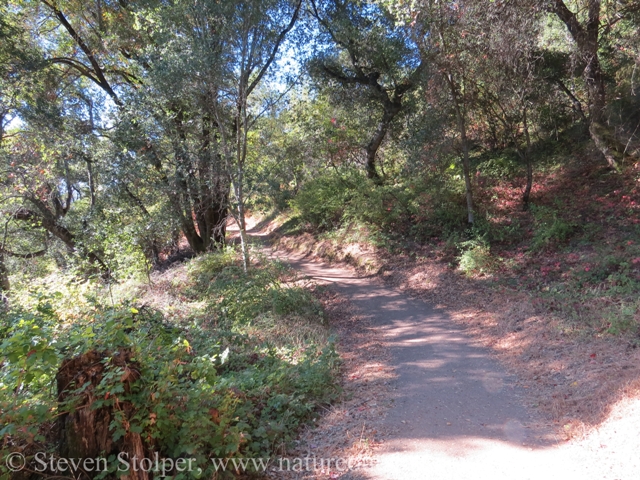
Early morning hikes provide a great chance to view wildlife
Leaving open grassland, the trail enters a mixed forest dominated by fragrant California Bay Laurel. Starkly naked Madrone trees twist and turn seeking any gap in the canopy above. As the forest thins the trail begins to transition into chaparral. I approach a corner and, to my delight, I see an animal I have only beheld once before.
Beauty

Coast Mountain Kingsnake (Lampropeltis zonata multifasciata)
It is a Coast Mountain Kingsnake (Lampropeltis zonata multifasciata). I know very little about herpetology. But there is no other snake in my area that looks anything like it. This one is about 20 inches long, with a conspicuous bulge in its last quarter. He appears to have a meal in him.
Growing up in a city on the East Coast, this is only the second time I have seen a Mountain Kingsnake. Despite descriptions of the snake as red/black/white, the “red” crossbands look orange to my unscientific eye. I remember the rhyme, “Red Touch Yellow, Kills a Fellow. Red Touch Black, Friend of Jack.” So I have no fear of this snake. In fact, my reaction is one of fascination with its striking colors.
The kingsnake’s color pattern mimics the venomous Coral Snake. When a harmless species imitates the appearance of a dangerous, venomous, or distasteful one, it is called Batesian Mimicry. Strangely, there are no venomous snakes in California that actually look like the kingsnake.
The black stripe over its head makes it difficult to distinguish the eyes and mouth. Despite its bold coloring, the crossbands effectively disguise its outline against leaf litter, pine needles and other organic debris on the ground.
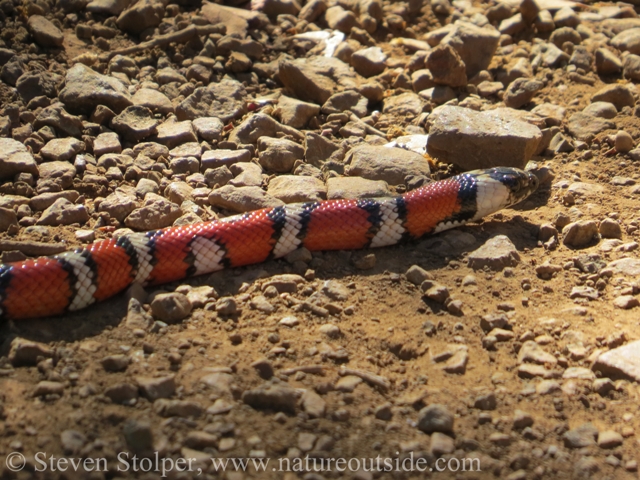
Coast Mountain Kingsnake
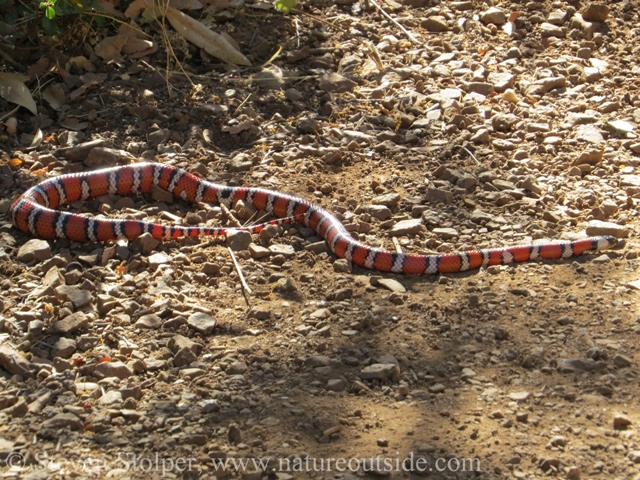
Coast Mountain Kingsnake in the open
The Mountain Kingsnake is versatile and inhabits most types of mountain habitat. It is diurnal and prefers open ground with rocks and downed trees for cover. It spends a great deal of time underground, under surface objects, or inside rock crevices.
The kingsnake is constrictor and a generalist, eating bird eggs, nestlings, other snakes, lizards and small mammals. What most people remember about the kingsnake is that it also eats rattlesnakes. Kingsnakes are immune to rattlesnake venom. In fact, when rattlesnakes detect the scent of a kingsnake they have been observed to display an instinctive behavior to hide and protect themselves.
Feeling Danger
As excited as I was, I made an effort to keep calm. I began to stalk up on the snake, taking care to move lightly and slowly.
I am not a “snake person.” Although I’m not phobic, I never learned to handle snakes and am generally uncomfortable around them. One of my “self improvement” projects this year is to learn proper handling techniques for reptiles to help me overcome my apprehension.
Just the same, I have encountered “exciting” snakes several times during my travels. In Zambia, a python fell from a tree overhead narrowly missing my canoe. In Australia, encounters with a red bellied black snake and a tiger snake left me appreciative of the relatively few dangerous snakes in North America.
So as I approached the kingsnake, my feeling was one of anticipation. I was eager to learn about this charismatic animal. But then something changed.
As I stepped closer, my attention was diverted from the snake to an interesting looking branch lying on the ground. Are you kidding me?!!! Here was a beautiful animal within feet of me and I was looking at a stick? I forced my attention back to the snake, just to have my eyes return to the stick. I became agitated. Why wouldn’t I look at the snake? Again, I forced my attention back to the snake. Again, my gaze returned to the stick. As I crept closer, the stick assumed a familiar shape. My mind began to think: danger, danger, DANGER!
I believe there are times when the subconscious can process information faster than the conscious mind. At some level your brain can recognize a threat before you become aware of it. It is easy to see the situation in the picture below because I composed the shot so it would be obvious. But hiking along the trail it was not clear at all.
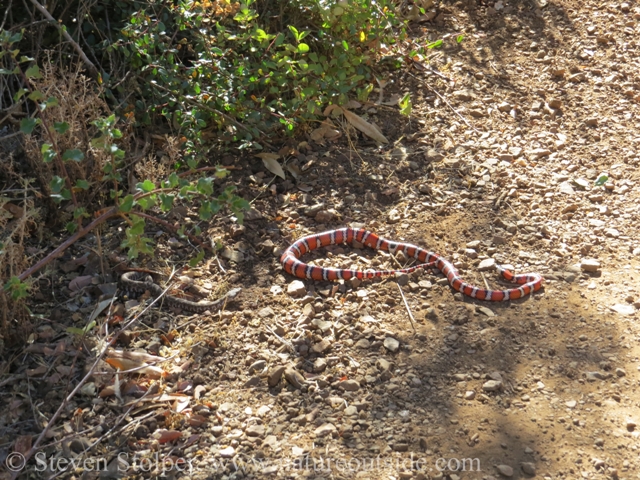
Can you see the threat?
Just a foot away from the kingsnake is a Northern Pacific Rattlesnake.
Danger
The Northern Pacific Rattlesnake (Crotalus oreganus oreganus) was young, only 10 inches long. Its body was colored like the leaf litter, broken with darker blotches. The animal remained motionless, but unlike the kingsnake, I felt menace from the rattlesnake.
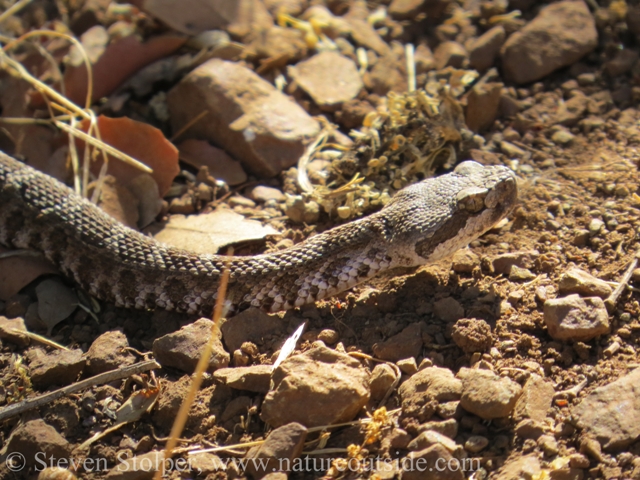
Northern Pacific Rattlesnake (Crotalus oreganus oreganus)
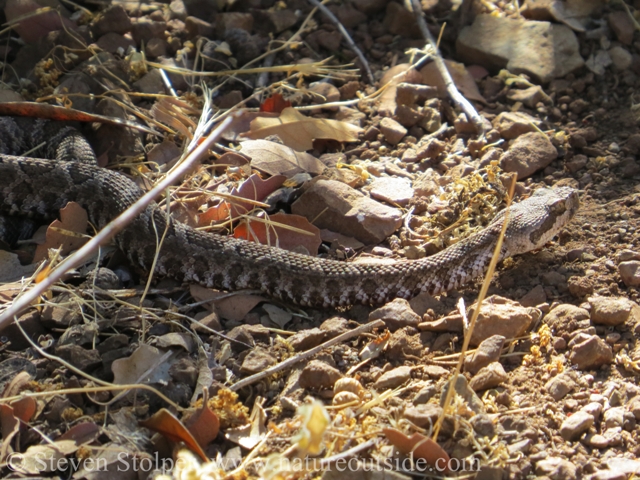
Northern Pacific Rattlesname. Dark splotches surrounded by light colored scales.
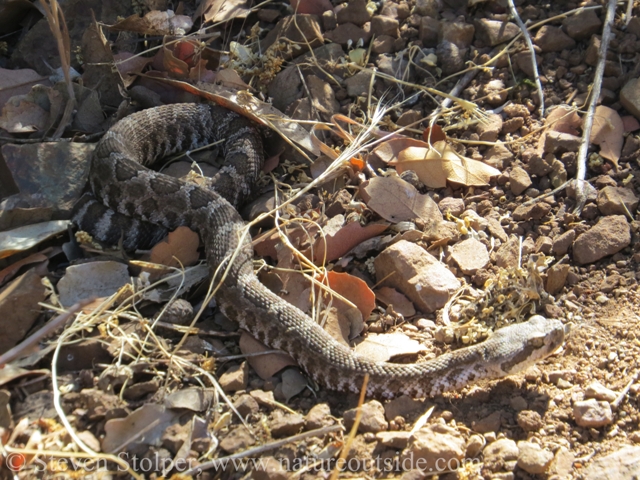
The Northern Pacific Rattlesnake is a “heavy bodied” snake
I gave the snake a wide berth as I approached the pair. The pit viper almost imperceptibly tracked my movements with its head. I think it is a Northern Pacific Rattlesnake because of the dark diagonal stripes over its eyes and the dark splotches on its body, lined with white scales. I usually find rattlesnakes to be calm with a forgiving nature. This one was seemed alert, but had adopted a “wait and see” attitude toward my presence.
I could hear a group of trail runners approaching. When they appeared a few minutes later, I steered the group around the serpents. A few lingered briefly, and that was enough for the snakes. The kingsnake slowly retreated into a hole, camouflaged by a low growing bush at the side of the trail. The rattlesnake described a slow U-turn and appeared to be headed into the forest. But once at the side of the trail, it coiled into a defensive posture and silently took stock of the situation.
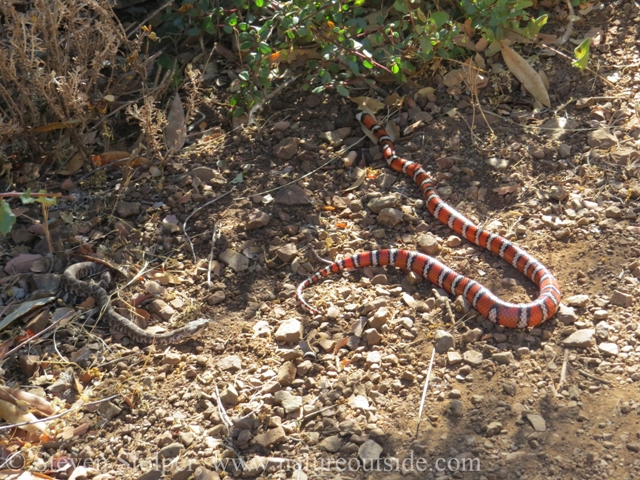
Kingsnake crawls slowly toward cover
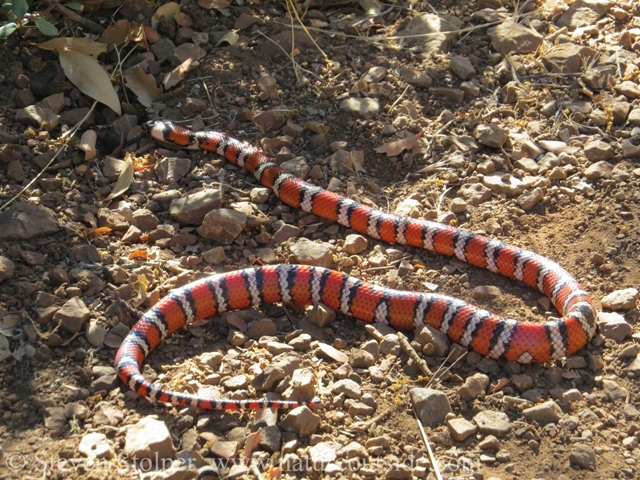
Kingsnake leaving
The rattlesnake’s retreat gave me an opportunity to photograph its tail. Notice how the rear of the body has crossbands instead of sploches?
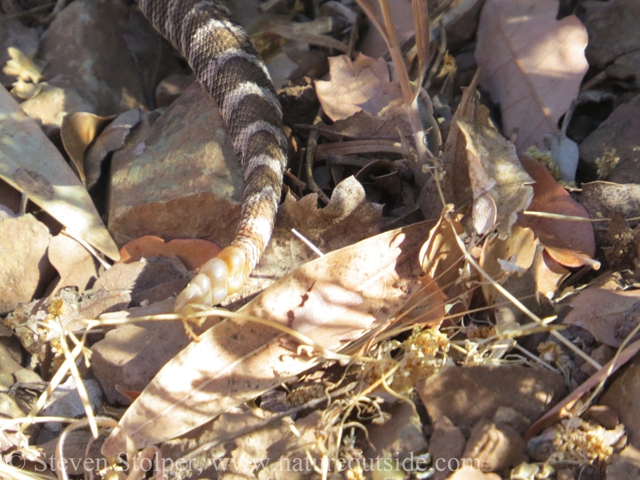
The rattle has 4 segments
Its rattle is composed of specialized semispherical scales. Specialized “tail-shaker muscles” agitate the rattle to warn off potential predators, or alert large ungulates to its presence so they do not step on it. Rattlers are slow moving snakes. So their defensive strategy is to warn instead of fleeing quickly like other snakes in my area.
The snake adds a segment to the base of its rattle each time it sheds its skin. So, young snakes can add three or four segments each year as they grow. I suspect this snake is only a year old. It is small for a large-growing snake and its rattle has only four small segments.
Here are a few pictures of the Northern Pacific Rattlesnake in its defensive coil. It is hard to communicate just how well the snake blends into its surroundings.
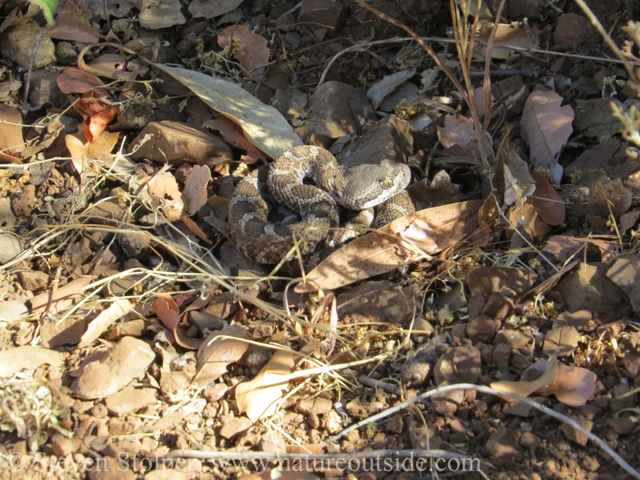
Rattlesnake is alert. Sizing up the situation.
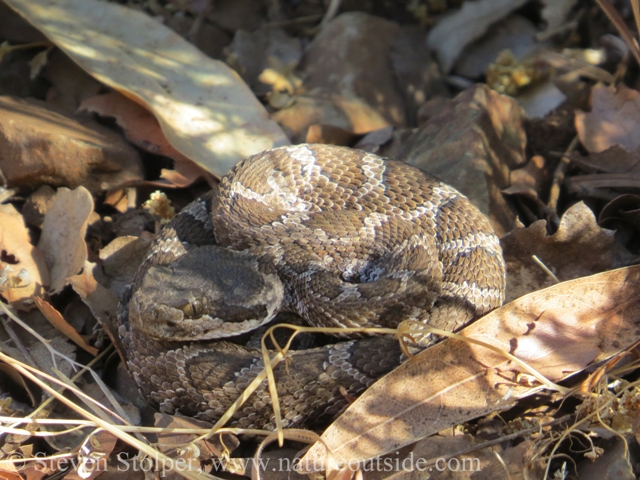
Pictures do not do justice to how well this snake is camouflaged.
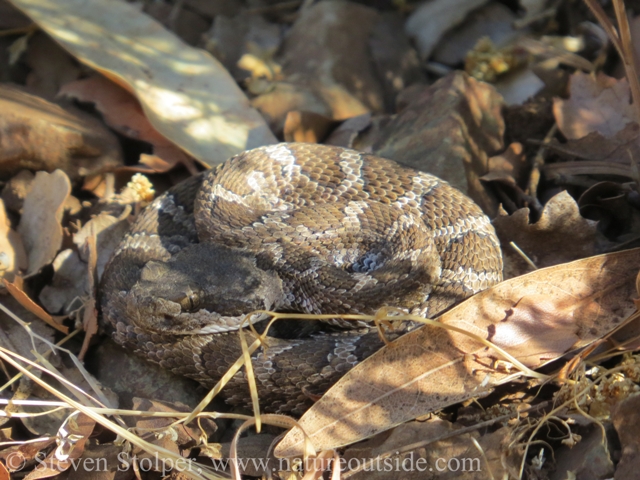
The pits are visible behind the nostrils
You can see one of the snake’s “pits” located behind its nostril. The opening leads to the loreal organ, which is a membrane that supports nerve endings sensitive to infrared radiation. It functions as an infrared “eye”. The pair of organs, one behind each nostril, gives the snake binocular infrared vision. This ability is invaluable to a slow moving, nocturnal, ambush predator. It helps it strike accurately in the darkness.
The rattlesnake primarily eats rodents. Fangs inject a hemotoxic poison into its prey that interferes with the ability of blood and muscle to obtain and use oxygen. Although the toxin can be dangerous to humans, we are rarely bitten. About 5 people die each year from rattlesnake bites in the United States. Compare this to the number of accidental poisoning deaths not snake related (33,041) in 2010. On average, almost two and a half times as many people die playing football (12) than from rattlesnake bites. So with reasonable vigilance, rattlesnake bites should not be a big concern.
An Amazing Sight
It was a rare treat to see the two snakes in such proximity. Either one by itself would be a rare sighting. I had heard that the two were “mortal enemies” and was flummoxed to find them together. It was clear that the kingsnake already had a meal in him and it is possible that the rattlesnake was aware of it and felt no threat from the other’s presence.
The encounter also served as a reminder to pay attention to that “inner voice” that warns when something isn’t right. Although I could not perceive the rattlesnake consciously, some part of my brain had detected it and was trying to let me know. The next time that feeling “taps you on the shoulder”, listen!
References
Field Guide to Amphibians and Reptiles of California, Robert C. Stebbins and Samuel M. McGinnis, University of California Press, 2012
More Snakes on NatureOutside
Gopher Snake – Master Impersonator!
Excuse me while I whip this out!
Twisted, Tangled, Trapped, and Rattling!
For fun facts and useful tips, join the free Bushcraft Newsletter.



Where was this trail? Looks like a good hike!
Nick, this is the Zinfandel Trail at Picchetti Open Space Preserve in Cupertino, California. It is a great hike through rolling hills and forest. Stevens Creek flows by one end of the trail. A 100-year-old winery sits beside the other.
can the red one be found in oklahoma bc im pretty sure i almost got bitten by one once
Tatum, Oklahoma has a snake that resembles the Coast Mountain Kingsnake. It is the Milksnake (Lampropeltis triangulum). It is in the same family as the Kingsnake and looks similar. Do some research and see if it looks like the snake you encountered.